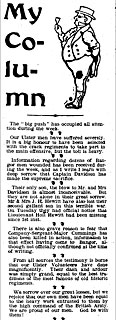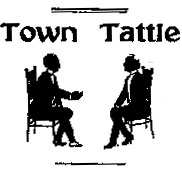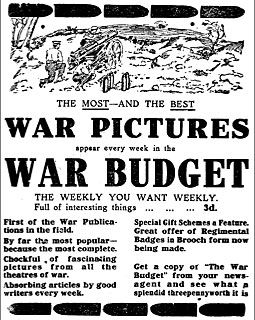
With a recent spate of writing pieces for the Historical Society website, sending Christmas and New Year emails, texting not-so-important but mutually interesting news, and generally trying to keep in touch with information between friends, I’ve been musing a bit on how and why we gather and disseminate information. Local publication Due North, for instance, communicates with its readership about items of common interest, generally local history.
Other specialised publications regularly featured on Have I Got News for You might bear such titles as Egg Weekly or Bus Ticket Collectibles and seem to find an avid readership. What on earth do they find to fill their pages? One home-style magazine in the USA has ten other associated titles, any of which can print your article that has failed to find a slot in Country Woman. Just as Samuel Pepys confided in his diary people have felt the need to record their feelings on paper and to search for pen friends with similar interests.
Nowadays it is not unusual for an individual to set up their own blog site, with webcam, to show and tell others all about their everyday life. Facebook, Twitter, Instagram etc. flourish. So it seems that these days everyone wants to communicate about their particular interest, and at length. We are almost profligate with information in a way undreamed of not so long ago.
Historically, the sending and receiving of messages was limited by the available technology. 17th century “post-stones”, used by sailors at refuelling landfalls like Cape Town, were large rocks with the name of your ship, date of arrival etc etched into the boulder and placed around the harbour with bundles of mail underneath. The tars then crossed their fingers and hoped that someone sailing in the right direction would be good enough to carry the messages to their home country. This worked until a more formal mail handling system came into play with the opening of a post office at Cape Town in 1792.
At Mount Stewart house there is a photocopy of an original letter from Admiral Lord Nelson to Viscount Castlereagh, Foreign Secretary of the time. Nelson is reporting to Castlereagh on the disposition of the enemy fleet as the British and the combined French and Spanish navies manoeuvre for the most advantageous position before the confrontation that they know is imminent. The letter is written from Nelson’s flagship Victory and dated October 2nd 1805, nineteen days before the Battle of Trafalgar.
I often wonder if Castlereagh actually received the letter before the death of Nelson on the 21st October. It was not until 5th November, 15 days later, that the news of the success of the British fleet and the death of its commander reached London, surely a most urgent message. It took, it seems, about 12 days in fair weather for a fast boat to reach Portsmouth, then mail was sent to London by road. Fast horses could make it in six hours barring incident; ten miles per hour for a journey by carriage was considered optimum speed. A semaphore system was in place taking around 35 minutes for the message to be transmitted high point to high point between the coast and London, but of course only operating in daylight. Nelson’s own communications with his ships was difficult, conferences being held on the Victory after transferring the various captains by tender to the flagship. The famous “England Expects…” call to battle had its wording altered because of the limitations of the flag signalling system.
Cave Paintings, hilltop beacons,smoke signals, jungle drums, Mr Morse’s code introduced in 1844 - from earliest times men have sought to reach out and pass messages on to others. What an advance pigeon post must have been. The Pony Express (young wiry fellows wanted, orphans preferred) was a lifeline on the American Frontier before being outmoded by the telegraph. The impact of Edison’s “Mary had a little lamb” crackling over the airwaves is hard to imagine in this sophisticated electronic age. How many radio telescopes are on alert for the first “hello” from outer space?
Nowadays everyone is so blasé about radio, telephone and e-mail. In our street the Queen’s Coronation was viewed agog by our gang on a home-made seven inch television screen, no casing, just the works. Jim Boyd’s big brother was the hero of the day! I remember too the excitement at home in the 1970s when, we teenagers having won the argument, a telephone was installed (just for emergencies)! However I must also make the point that in my great-grandmother’s day, a postcard sent from Belfast to Carrickfergus in the morning could successfully advise of an arrival for tea later in the day! Beat that, Post Office/Royal Mail/UPS!
Historical messsengers got famous just for delivering the news, and in some cases, when it was on the bad side, surviving! Would there be a marathon without the approximately 25 miles dash by Pheidippides who, after gasping “Nike” [victory], collapsed and died from exhaustion? Would silversmith Paul Revere’s name be known if he had used a mobile phone? The Battle of New Orleans need never have been fought had the news of the Treaty of Ghent, signed two weeks previously, reached the New World in time. The Titanic disaster would have been complete without radio communications, with it 800 people were saved.
What prompted the above (very) random musings was when I was researching the role of newspapers in the First World War, practically the only source of public information during those years, and in particular the part played by local newspapers in Northern Ireland. Consider that there was no home radio or television. Cinema “newsreels” were generally patriotic propaganda pieces featuring Charlie Chaplin, and anyway, months out of date.

All over the UK, until 1913, the small town newspaper served as a public notice-board for all sorts of community announcements including the usual hatches, matches and despatches. It informed readers of handy hints, dates of agricultural shows, the arrival of the new season’s fabrics in the local drapers. Banner headlines, of the sort tabloids would be proud of, proclaimed the grisliest of murders – “Head Found in Beer Barrel”. Political meetings, of which there were many in Ulster, were reported in great detail, for these were the gun-running years. Current numbers of workhouse inhabitants were worried over. The local gentry’s movements and wedding presents were chronicled, always with deference and literary doffing of the cap. In the absence of photographs, which were few and far between, line-drawn advertisements provided most of the illustrations and give fascinating insights into the preoccupations of the time. Opinions were blatantly and gloriously politically incorrect. People knew their place.
In 1914 everything changed, although the outbreak of war was reported almost nonchalantly inside - no one held the front page for breaking news in those days, devoted as it was to advertising, and until paper was rationed, the Dead Donkey! was never dropped. The big dailies communicated government edicts and central control of the country was rolled out from London. Even though suffering paper rationing, local papers suddenly came into their own. The Spectator reduced from 8 pages to 4 and locally was the means of interpretation of the Defence of the Realm Act (DORA) which covered almost every aspect of everyday life. War news consisted of bulletins reprinted from the main daily papers on the mainland, letters from the front to the folks at home, and later, lists of dead and wounded. Reports came through of cavalry charges and new-fangled weapons like tanks, and troops learning how to make Christmas pudding in a sock. The recipe advised washing the sock before use. Advertisements featured men in uniform and vegetables were given macho military names like The Dreadnought, a sort of super-turnip, as big as a battleship.

And of course, the troops at the front had no more idea of what was going on at home than their loved ones did of life in the trenches. Personal mail was heavily censored. A frequent request from the troops was that a copy of the “oul paper” be sent to them. However out of date it might have been when it arrived, the paper, bringing news of their home town, was circulated around the battalion, most of the men, in “Pals” tradition, being from the same area. It then finished up lining boots or being recycled in the latrines.
In those days and until the advent of home radio, the local newspaper was the only comprehensive means of communication between those at the Front, in Government and at home. Contrast this with how TV broadcasters nowadays like the BBC and CNN reporters on the spot bring war, parliamentary debate, disasters, and entertainment live into our living rooms, all at the touch of a button on the remote control. It changed everything.
